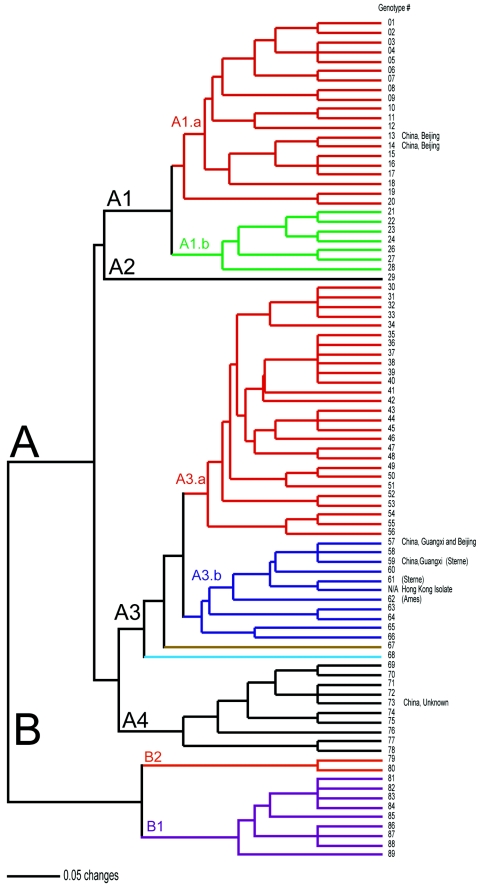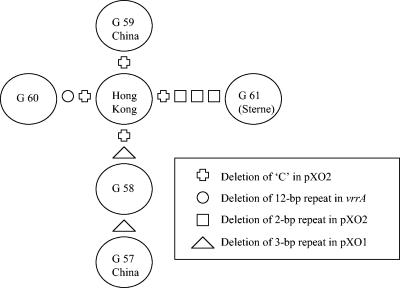Abstract
We used multiple-locus variable-number tandem repeat analysis (MLVA) and pagA sequencing to genotype a Bacillus anthracis isolate from a fatal case of human anthrax in Hong Kong. The isolate has a unique MLVA genotype, is related to the Sterne and Ames strains, and is consistent with genotypes identified in China.
Human anthrax, which can include cutaneous, gastrointestinal, and inhalation forms, is caused by Bacillus anthracis. The type of anthrax is directly related to the route of infection. Inhalation anthrax, which was historically associated with textile mill workers and most recently with bioterrorism, occurs upon inhaling spores. Cutaneous anthrax is generally the result of infection via a skin abrasion while handling contaminated animal products, while gastrointestinal anthrax occurs upon eating contaminated meat. Human anthrax is very rare worldwide, and only three cases have been reported in Hong Kong in the last 20 years.
On 27 May 2003, a 2-year-old boy, who was in apparent good health prior to this illness, became ill with fever and anorexia as main symptoms. His condition rapidly deteriorated 3 days later with abdominal pain, irritability, vomiting, and shortness of breath. He was pronounced dead shortly after admission to a hospital. B. anthracis was isolated from both cerebrospinal fluid and blood. Postmortem examination revealed the presence of gram-positive rods in mesenteric lymph nodes and brain tissues. Although pathological findings suggested an oral route of transmission, an extensive epidemiological investigation and culturing of food and environmental samples from the victim's home, nursery, playgrounds, restaurants, supermarkets, and meat suppliers that might have been linked to the victim's activities were all negative for B. anthracis.
We used multiple-locus variable-number tandem repeat (VNTR) analysis (MLVA) and pagA sequencing (protective antigen [PA] genotype) to molecularly characterize the isolate from this case in an attempt to gain insight into its potential origin. MLVA determines the copy number of VNTRs at eight genetic loci (six chromosomal and one on each of the two virulence plasmids, pXO1 and pXO2). MLVA has been used to differentiate 426 B. anthracis isolates into 89 distinct genotypes and has been used to study the ecology of anthrax and to subtype isolates during the 2001 bioterrorism-associated anthrax outbreak in the United States (1, 2, 4). We used MLVA to analyze eight VNTRs within the B. anthracis genome as previously described (1, 2). The allele sizes (in nucleotides, corrected to the sizes reported by Keim et al. (2), for the eight loci were identified as vrrA = 313, vrrB1 = 229, vrrB2 = 162, vrrC1 = 583, vrrC2 = 532, CG3 = 158, pXO1 = 129, and pXO2 = 142 and resulted in a unique MLVA genotype within the A3.b cluster as originally described by Keim et al. (2) (Fig. 1). This cluster includes B. anthracis isolates from China in addition to well-known strains such as Ames and Sterne.
FIG.1.
MLVA-based dendrogram generated using unweighted-pair group method arithmetic average cluster analysis of raw genotype scores of 88 diverse B. anthracis strains (2) and the Hong Kong isolate. Genotype numbers are listed as reported by Keim et al. (2). Note that genotype 25 is not present since reanalysis of the isolate indicated that it was missing the pX02 virulence plasmid. We have indicated the locations of the Sterne strain, the Ames strain, and all Chinese strains. Included next to the Chinese strains are the provinces where the strains were isolated.
It should be noted that the pXO1 allele reported here is 3 bp larger than the comparable allele from Keim et al. (132 versus 129 bp), based upon DNA sequence comparison. Since minor “real size” fragment length discrepancies, based upon DNA sequence, may exist in the sizes initially reported by Keim et al. (2; P. Keim, personal communication), we confirmed the accuracy of the genotype assignment by MLVA typing the Hong Kong isolate in parallel with the B. anthracis isolates representing the 89 genotypes presented previously (2). In addition, this is the first description of a 142-bp pXO2 allele (between the 141-bp and 143-bp alleles) due to an insertion of an additional C in a poly(C) tract.
PA is one of the three anthrax toxin proteins and is key to developing immunity to anthrax. Sequencing of the gene that encodes PA (pagA) has been used to subtype 26 diverse B. anthracis isolates into six PA genotypes and was also used during the 2001 bioterrorism-associated anthrax outbreak (1, 3). Sequencing of the pagA gene (2,294 bp) was done as described by Hoffmaster et al. (1) and identified this isolate to be of PA genotype I. This PA genotype is the same as that of the Sterne and Ames strains of B. anthracis (3).
MLVA and pagA sequencing of the isolate causing this rare case of anthrax revealed that the isolate is closely related to strains such as Sterne and Ames and is consistent with genotypes previously identified in China. In fact, the isolate differs from genotype 59, a Chinese strain isolated from soil in the Guangxi province, by a single nucleotide addition in the pX02 locus (Fig. 2) (2). This is particularly interesting considering the geographic proximity of these two regions, the inland waterways that link them, and the extensive trade between Hong Kong and Guangxi. While the genotype of this isolate appears consistent with this region, the proximal source of the B. anthracis isolate that caused this case remains unknown. In the future, if more extensive databases of subtyped B. anthracis strains from this region become available, it may be possible to determine the origin of this strain with greater confidence.
FIG. 2.
Illustration of the mutational steps that separate the Hong Kong isolate and the closely related A3b strains.
REFERENCES
- 1.Hoffmaster, A. R., C. C. Fitzgerald, E. Ribot, L. W. Mayer, and T. Popovic. 2002. Molecular subtyping of B. anthracis and the 2001 bioterrorism-associated anthrax outbreak, United States. Emerg. Infect. Dis. 8:1111-1116. [DOI] [PMC free article] [PubMed] [Google Scholar]
- 2.Keim, P., L. B. Price, A. M. Klevytska, K. L. Smith, J. M. Schupp, R. Okinaka, P. J. Jackson, and M. E. Hugh-Jones. 2000. Multiple-locus variable-number tandem repeat analysis reveals genetic relationships within Bacillus anthracis. J. Bacteriol. 182:2928-2936. [DOI] [PMC free article] [PubMed] [Google Scholar]
- 3.Price, L. B., M. Hugh-Jones, P. J. Jackson, and P. Keim. 1999. Genetic diversity in the protective antigen gene of Bacillus anthracis. J. Bacteriol. 181:2358-2362. [DOI] [PMC free article] [PubMed] [Google Scholar]
- 4.Smith, K. L., V. DeVos, H. Bryden, L. B. Price, M. E. Hugh-Jones, and P. Keim. 2000. Bacillus anthracis diversity in Kruger National Park. J. Clin. Microbiol. 38:3780-3784. [DOI] [PMC free article] [PubMed] [Google Scholar]




